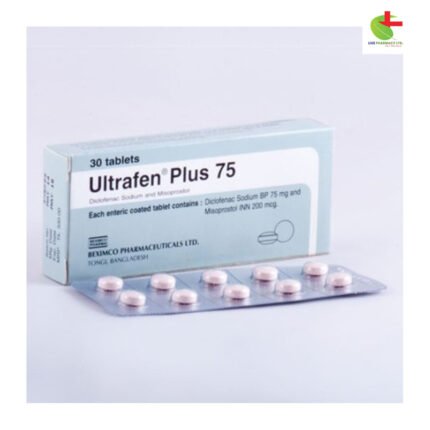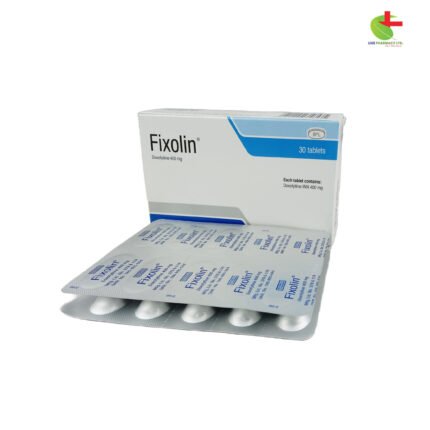Deflux Meltab
35.00৳ Strip
- Domperidone, branded as Deflux Meltab by Live Pharmacy, is a potent gastroprokinetic agent.
- It effectively manages dyspeptic symptoms such as abdominal pain, nausea, and reflux associated with delayed gastric emptying.
- Domperidone works by blocking dopamine receptors in the stomach and Chemoreceptor Trigger Zone, enhancing gastrointestinal motility.
- Dosages are tailored based on age and severity of symptoms, providing relief from acute nausea, vomiting, and dyspepsia.
- Live Pharmacy ensures quality and reliability, adhering to strict storage conditions to maintain medication potency and efficacy.
 Brand
Brand
|
Beximco Pharmaceuticals Ltd |
|---|---|
 Generics
Generics
|
Domperidone Maleate |
 Type
Type
|
Tablet |
Indications
Dyspeptic symptom complex, often associated with delayed gastric emptying, gastroesophageal reflux, and esophagitis, including:
- Epigastric sense of fullness, abdominal distension, upper abdominal pain
- Eructation, flatulence, early satiety
- Nausea and vomiting
- Heartburn with or without regurgitation of gastric contents in the mouth
- Non-ulcer dyspepsia
Acute nausea and vomiting of functional, organic, infectious, or dietetic origin, and induced by radiotherapy or drug therapy or in migraine.
Used in Parkinson’s disease for dopamine-agonist induced nausea and vomiting.
Speeds barium transit in follow-through radiological studies.
Pharmacology
Domperidone is a dopamine antagonist that primarily blocks dopamine receptors in the Chemoreceptor Trigger Zone (CTZ) and stomach. It enhances gastrointestinal motility by regulating gastric emptying, antral and duodenal peristalsis, pyloric contraction, esophageal peristalsis, and lower esophageal sphincter pressure to prevent gastric content regurgitation.
Dosage & Administration
Domperidone should be taken 15-30 minutes before meals and, if necessary, before retiring.
The usual recommended oral dose of Domperidone is as follows:
- Adults: 10-20 mg (1-2 tablets or 10-20 ml suspension), every 6-8 hours daily. Maximum dose is 80 mg daily.
- Children: 0.2-0.4 mg/kg body weight every 6-8 hours daily.
In dyspeptic symptoms:
- Adults: 10-20 mg (1-2 tablets or 10-20 ml suspension), every 6-8 hours daily.
- Children: 0.2-0.4 mg/kg body weight every 6-8 hours daily.
In acute and sub-acute conditions (mainly in acute nausea and vomiting):
- Adults: 20 mg (2 tablets or 20 ml suspension), every 6-8 hours daily.
- Children: 0.2-0.4 mg/kg body weight every 6-8 hours daily. Maximum treatment period is 12 weeks.
By rectum in suppositories:
- Adults (including elderly): 30-60 mg every 4-8 hours.
- Children: Maximum daily dose is 30 mg for those weighing 10 to 25 kg. Dose may be divided throughout day if necessary. Maximum treatment period is 12 weeks.
Interaction
Concomitant administration of anticholinergic drugs may antagonize domperidone’s effects. Antacids and antisecretory drugs should not be given simultaneously with domperidone as they lower its oral bioavailability. Domperidone metabolism is affected by CYP3A4 inhibitors.
Contraindications
Domperidone is contraindicated in patients with hypersensitivity to the drug and in neonates. Avoid use in gastrointestinal hemorrhage, mechanical obstruction, or perforation. Contraindicated in patients with prolactin-releasing pituitary tumors (prolactinomas).
Side Effects
Rare side effects include transient intestinal cramps and extrapyramidal phenomena, particularly in children. Hyperprolactinemia may cause galactorrhea and gynecomastia. Allergic reactions such as rash and urticaria have been reported.
Pregnancy & Lactation
Domperidone should only be used during the first trimester if benefits outweigh risks. Excreted in breast milk at lower concentrations compared to plasma levels.
Precautions & Warnings
Use with caution in children due to potential extrapyramidal reactions, and in patients with hepatic impairment or severe renal insufficiency.
Use in Special Populations
Infants and patients with impaired liver or kidney function require close monitoring due to altered drug metabolism and clearance.
Overdose Effects
Symptoms may include drowsiness, disorientation, and extrapyramidal reactions. Management includes activated charcoal and supportive care.
Therapeutic Class
Motility stimulants and dopamine antagonists categorized as prokinetic drugs.
Storage Conditions
Store below 30°C, protected from light and moisture. Keep out of reach of children.













Reviews
There are no reviews yet.